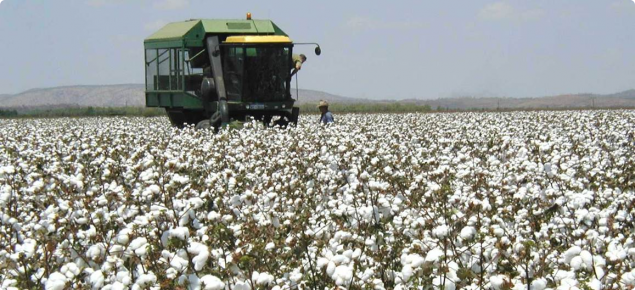History of growing cotton
Cotton was grown commercially in the ORIA between 1964 and 1974. The early industry was subsidised by the Western Australian Government.
The industry failed due to an inability to control major insect pests, and problems with quality. The industry never achieved economic yields, and short fibre length and discolouration resulted in substantial discounts.
The main features of the old cotton industry were:
- The crop was grown over the wet season in accordance with an eastern Australian cropping calendar.
- The industry was totally reliant on chemical insecticides for pest control.
- The crop was harvested over an extended period with weather damage common.
Current situation
Cotton is an available cropping option for the ORIA. A cotton production system based on genetically modified varieties has been developed for the ORIA, based on intensive local research which started in 1996.
Production guides for the ORIA have been published by the Cotton Catchment Communities CRC as NORpak. Some features of the new production system are:
- The crop is grown during the dry season to avoid pink bollworm (Pectinophora gossypiella) and cluster caterpillar (Spodoptera litura).
- Bollworm (Helicoverpa armigera) and budworm (H. punctigera) are completely controlled by the Bollgard II® technology and research is continuing.
- Roundup Ready Flex® allows in-crop use of glyphosate for weed control and eliminates the need for pre-emergent herbicides. This means the crop can be planted earlier in the season and weeds can be controlled later in the crop cycle. Early planting is essential to ensure good early season growth and harvest before lint quality is affected by wet season rain.
- Pest management is based on integrated pest management (IPM) principles.
- Furrow irrigation is normal on the clay soils.
Performance
- The planting window is five weeks between 1 March and 1 May.
- Maturity takes about 180 days for most varieties.
- Yield averages around 8.5 bales/ha on clay soils and up to 13 bales/ha on levee soils with drip irrigation.
- Water requirement ranges from 4.5ML/ha with drip irrigation to 7.5ML/ha using furrow irrigation.
- Varieties are available that reliably produce base grade for fibre length and micronaire.
- Early season mirids and aphids are the main insect pests and require control during the season. Cotton stainers (Dysdercus spp.) have become more prevalent towards the end of the season in recent years.
- Disease is not normally an issue, but alternaria leaf blight can cause serious defoliation in cold years.
Opportunities
Cotton is seen as a base field crop that will need a minimum area to achieve viability. This is believed to be at least 5000 hectares. Partnerships with ginners and marketers are essential for a future cotton industry.
Drip irrigated cotton may be a suitable crop for the extensive Cockatoo sands surrounding the irrigation area. DAFWA is currently scoping the Cockatoo sands to define the extent of this resource. Significant areas are not expected to become available for some time.
Water allocation is secure and the crop may be safely forward sold. It may be prudent to forward sell no more than 6 bales/ha.
Fusarium and Verticillium have not been recorded in cotton in the ORIA.
Negatives
The small Kununurra gin has limited capacity and ginning costs are high. Major investment in ginning and harvesting infrastructure is required to service a viable cotton industry.
Input and freight costs are relatively high.
Mid-season rain or extended overcast conditions can cause serious yield reduction. These events are rare but must be considered.
The risk of storm damage increases as harvest is delayed beyond early October.
Maximum achievable yields are about 80% of those possible in eastern Australia due to lower radiation received in the dry season.
Managing resistance
Protection against insect resistance for as long as possible is vital. Strict stewardship and quality control standards will be required.
Under the approved Resistance Management Plan for Bollgard II®, growers must destroy all genetically modified (GM) plants immediately after harvest and remove volunteer and ratoon plants (sprouting from roots). A refuge area must be planted so that small areas of non-GM cotton continue to be grown in the local area capable of providing large numbers of Helicoverpa spp. moths that have not been exposed to selection. These will dominate matings with any survivors from the GM crop and help keep resistance to a low level.
IPM principles tailored to regional requirements will minimise reliance on conventional insecticides.
Two native Gossypium (cotton) species exist in north-western Australia. However, the likelihood of gene transfer by outcrossing between GM cotton and an Australian variety is extremely low because of genetic incompatability.
Reduced pesticide application could allow the numbers of other insects to increase. Leafhoppers, mites, aphids and other pests are more abundant than in sprayed conventional cotton and may need more attention.
GM regulation
All dealings with GM material in Australia are controlled by the Gene Technology Regulator under the powers of the Gene Technology Act 2000. The Regulator undertakes a thorough evaluation of the health and environmental impacts of all GM releases into the environment, including research trials.
Future prospects
In 2016, Bollgard 3® was registered for use in Australia. An advantage of the new product over earlier GM cotton types is that it is purported to control cluster caterpillar, Spodoptera litura. This could enable earlier sowing (optiminally February) on light soil types with all weather traficability and maximise yield and fibre quality. This potential requires rigorous evaluation.
The availability of light soil types near Kununurra combined with the commercial availability of Bollgard 3® varieties will encourage a reevaluation of cotton as an industry for the ORIA.


